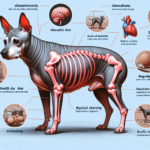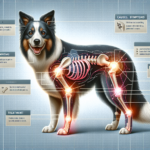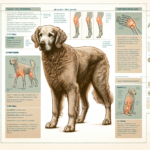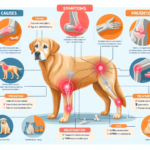Chinese Crested Joint Pain: Causes, Symptoms, Prevention, and Treatment
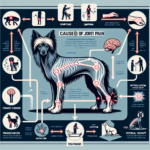
Introduction
The Chinese Crested is a unique and charming breed known for its distinctive appearance and affectionate nature. Originating from China, this breed comes in two varieties: the Hairless, which has smooth skin with tufts of hair on the head, tail, and feet, and the Powderpuff, which is covered with a soft, silky coat. Despite their small size and delicate appearance, Chinese Cresteds are known for their lively and playful personalities.
Like many small breeds, Chinese Cresteds are prone to certain health issues, including dental problems, eye conditions, and skin disorders. However, one of the most significant concerns for this breed is joint pain, which can severely impact their quality of life.
Joint health is particularly important for Chinese Cresteds due to their active nature and the physical demands placed on their small frames. Ensuring that their joints remain healthy can help prevent pain and mobility issues as they age, allowing them to lead happy and active lives.
Breed-Specific Joint Pain Risks
Genetic Predisposition
Chinese Cresteds, like many purebred dogs, have a genetic predisposition to certain joint-related issues. Hip dysplasia, a condition where the hip joint does not fit properly into the hip socket, is one such concern. This can lead to arthritis and significant pain over time. Additionally, elbow dysplasia, where the elbow joint develops abnormally, can also be a problem in this breed.
Age-Related Risks
As Chinese Cresteds age, the risk of developing joint pain increases. Arthritis, a common condition in older dogs, can cause inflammation and pain in the joints. For Chinese Cresteds, it is essential to monitor their joint health as they reach middle age, typically around 6-8 years old, to catch any early signs of joint issues.
Activity Level and Joint Stress
Chinese Cresteds are known for their playful and energetic nature. While regular exercise is crucial for their overall health, excessive or high-impact activities can put stress on their joints. Activities such as jumping from heights or running on hard surfaces can exacerbate joint problems, making it essential to balance their activity levels to protect their joints.
Common Symptoms of Joint Pain in Chinese Cresteds
General Symptoms
- Limping or favoring one leg
- Stiffness, especially after rest
- Reluctance to jump or climb stairs
- Decreased activity or playfulness
- Visible discomfort or pain when touched
Breed-Specific Symptoms
In Chinese Cresteds, joint pain may manifest in subtle ways. Owners should watch for changes in their dog’s gait, such as a “bunny hop” motion when running, or an unusual posture when sitting or lying down. Additionally, Chinese Cresteds may become more irritable or withdrawn if they are experiencing joint pain.
When to Consult a Vet
If you notice any of the above symptoms in your Chinese Crested, it is essential to consult a veterinarian promptly. Early intervention can help manage joint pain and prevent further deterioration. Regular veterinary check-ups are also crucial for monitoring your dog’s joint health and catching any issues early.
Preventive Measures for Joint Health
Exercise Recommendations
Regular, low-impact exercise is vital for maintaining joint health in Chinese Cresteds. Activities such as walking, swimming, and gentle play can help keep their joints flexible and muscles strong without putting excessive stress on their joints. Avoid high-impact activities like jumping or running on hard surfaces.
Dietary Suggestions
A balanced diet rich in essential nutrients can support joint health. Look for dog foods that contain glucosamine and chondroitin, which help maintain cartilage health. Omega-3 fatty acids, found in fish oil supplements, can also reduce inflammation and support joint health. Always consult your veterinarian before adding supplements to your dog’s diet.
Weight Management
Maintaining a healthy weight is crucial for reducing joint stress in Chinese Cresteds. Excess weight can exacerbate joint problems and lead to additional health issues. Monitor your dog’s weight and adjust their diet and exercise routine as needed to keep them at an optimal weight.
Early Screening and Monitoring
Regular veterinary check-ups are essential for early detection of joint issues. Your veterinarian may recommend screening tests such as X-rays or joint fluid analysis to assess your dog’s joint health. Early detection allows for timely intervention and better management of joint pain.
Treatment Options for Joint Pain
Non-Surgical Treatments
For mild to moderate joint pain, non-surgical treatments can be effective. These may include:
- Medications: Anti-inflammatory drugs and pain relievers can help manage pain and reduce inflammation.
- Physical Therapy: Exercises and stretches designed to improve joint flexibility and muscle strength.
- Lifestyle Adjustments: Modifying your dog’s activity level and providing a comfortable living environment.
Surgical Options
In severe cases of joint pain, surgical intervention may be necessary. Common surgical options include:
- Joint Replacement: Replacing a damaged joint with an artificial one.
- Arthroscopy: A minimally invasive procedure to clean out the joint and remove damaged tissue.
- Osteotomy: Cutting and realigning bones to improve joint function.
Your veterinarian will determine the best surgical option based on your dog’s specific condition.
Alternative Therapies
Alternative therapies can complement traditional treatments and provide additional relief. These may include:
- Acupuncture: Inserting thin needles into specific points to relieve pain and improve joint function.
- Hydrotherapy: Water-based exercises that reduce joint stress while improving strength and flexibility.
- Massage: Gentle massage techniques to reduce muscle tension and improve circulation.
Lifestyle and Management Tips
Daily Care Routine
A consistent daily care routine can help manage joint pain in Chinese Cresteds. This may include:
- Regular, gentle exercise to maintain joint flexibility.
- A balanced diet with joint-supporting nutrients.
- Administering any prescribed medications or supplements.
- Monitoring your dog’s weight and adjusting their diet as needed.
Modifying the Home Environment
Making your home more comfortable for a dog with joint pain can significantly improve their quality of life. Consider the following modifications:
- Provide ramps or steps to help your dog access furniture or climb stairs.
- Use orthopedic beds to support their joints while resting.
- Ensure that food and water bowls are at a comfortable height to reduce strain.
Long-Term Management
Long-term management of joint pain involves ongoing care and monitoring. Regular veterinary check-ups, maintaining a healthy weight, and providing appropriate exercise and nutrition are key components. Additionally, staying informed about new treatments and therapies can help you provide the best care for your Chinese Crested.
FAQs About Chinese Cresteds and Joint Pain
What are the early signs of joint pain in Chinese Cresteds?
Early signs of joint pain include limping, stiffness, reluctance to move, and changes in behavior such as irritability or withdrawal. If you notice any of these symptoms, consult your veterinarian promptly.
Can joint pain in Chinese Cresteds be prevented?
While genetic predisposition cannot be changed, you can take preventive measures to reduce the risk of joint pain. These include providing regular, low-impact exercise, maintaining a healthy weight, and ensuring a balanced diet with joint-supporting nutrients.
Are there specific exercises that are better for Chinese Cresteds with joint pain?
Yes, low-impact exercises such as walking, swimming, and gentle play are ideal for Chinese Cresteds with joint pain. Avoid high-impact activities like jumping or running on hard surfaces.
What dietary supplements can help with joint health in Chinese Cresteds?
Supplements containing glucosamine, chondroitin, and omega-3 fatty acids can support joint health. Always consult your veterinarian before adding supplements to your dog’s diet.
When should I consider surgery for my Chinese Crested’s joint pain?
Surgery may be considered if non-surgical treatments are ineffective and your dog is experiencing severe pain or mobility issues. Your veterinarian will determine the best surgical option based on your dog’s specific condition.
Conclusion
Joint pain is a significant concern for Chinese Cresteds, but with proper care and preventive measures, you can help ensure your dog maintains healthy joints throughout their life. Regular exercise, a balanced diet, weight management, and early screening are crucial components of joint health. If your dog does develop joint pain, there are various treatment options available, from medications and physical therapy to surgical interventions and alternative therapies. By staying informed and proactive, you can help your Chinese Crested lead a happy, active, and pain-free life.
Remember to consult your veterinarian regularly to monitor your dog’s joint health and address any concerns promptly. With the right care and attention, you can support your Chinese Crested’s joint health and overall well-being.

